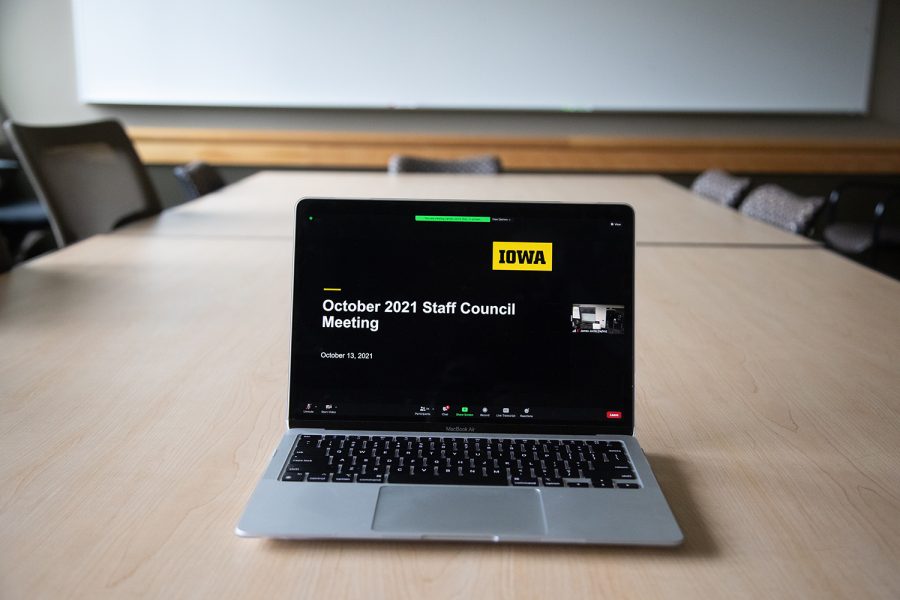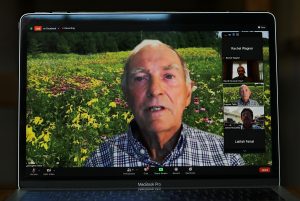UI faces shrinking talent pool, significant market challenges as the pandemic continues
The University of Iowa’s University Human Resources discussed facing significant market challenges and a shrinking talent pool of potential staff at a UI Staff Council meeting on Wednesday. This comes after the pandemic created opportunities for employees to work from home.
Photo illustration by Cecilia Shearon.
October 13, 2021
The University of Iowa faces a shrinking talent pool of potential workers as the pandemic continues.
The significant market challenges the UI is experiencing are the same ones occurring across all industries, Keith Becker, senior director of talent acquisition at the UI said at a meeting of the UI Staff Council on Wednesday.
“We were in a pretty tight labor market pre-pandemic, [and] the pandemic only amplified that,” Becker said. “Employees were exposed to things throughout the pandemic that they weren’t previously doing, such as the ability to work from home or have a more integrated work-life balance.”
These aspects of the pandemic have caused employees to reevaluate whether they want to return to the workforce or a particular career, Becker said.
Along with facing the tight labor market, the UI also faces a low unemployment rate that the pandemic has worsened across the country, Becker added.
“Even with these employees leaving the workforce, we [already] had that low unemployment rate,” he said. “I don’t know that they’re necessarily returning back to the workforce, and our talent pools are shrinking.”
The UI’s human resource department is also seeing an increase in the Consumer Price Index, he said.
“This is resulting in employees or applicants wanting more from a salary standpoint. We’re seeing this locally with Walmart and Target offering $15 an hour for entry level workers plus some tuition benefits,” Becker said. “Employers are starting to get creative on how to deal with shortages.”
The way to address these challenges, Becker said, is to understand the workforce in aspects such as demographics of departments, potential retirements, and staff mobility.
“Understanding this will help us understand where there could be potential gaps if employees do start to exit the university,” Becker said. “It’ll also help us identify what key positions we need to prepare for.”
The UI is also encouraging supervisors to collect qualitative data from stay interviews — where supervisors check in with employees after the academic year ends — to understand what staff are looking for at the university, including what keeps them engaged within the department, Becker said.
The data from the interviews will also help the UI recognize potential flight risks or people that could exit, he said.
When looking for ways to increase retention, Human Resources looks at both internal and external factors such as salary and market, said Trevor Glanz, UI director of compensation and classification and human resources data management.
“When we look at money internally, it’s really specific to the department,” he said. “We encourage looking at ‘what are they being paid? How are the roles similar? What about others in the same job or in the same department?’”
Becker said recruitment will help the UI prepare for the anticipated needs of workers, as well as create as much runway as possible and perform a compensation analysis before they begin to advertise.
“[Recruitment] allows us to think differently about our current workforce. If we can shift significant or unique responsibilities to current staff,” Becker said. “The more unique the position is or the more experience that we require, the narrower the pool of people that we can attract to the position.”
The more the UI can do to shift the difficult-to-fill responsibilities, the broader the pool of potential workers they will be able to target, he said.
Becker also encouraged the idea of looking at what individual positions will need in the future as compared to previous years.
“By preparing or having these conversations, it allows us to better understand our competition, so we know what we’re trying to sell when we do go out to do that recruitment,” Becker said. “It also allows us to be intentional with our recruitment practices.”
Becker said that by being intentional with their recruitment practices, the UI is able to create flexibility with their job descriptions and qualifications, invest time and resources toward sourcing in order to increase pools, streamline their hiring process, and offer creative incentives to entice potential workers
The UI’s goal is to offer a competitive employment package, he said, while looking at what they are competing against.
“We look at what all we can offer. We have the compensation, we have the benefits, we have other perks, the university, the community, the culture, DEI initiatives,” Glanz said. “How can we sell the whole package that we have as a university to our candidates and to our current staff?”






